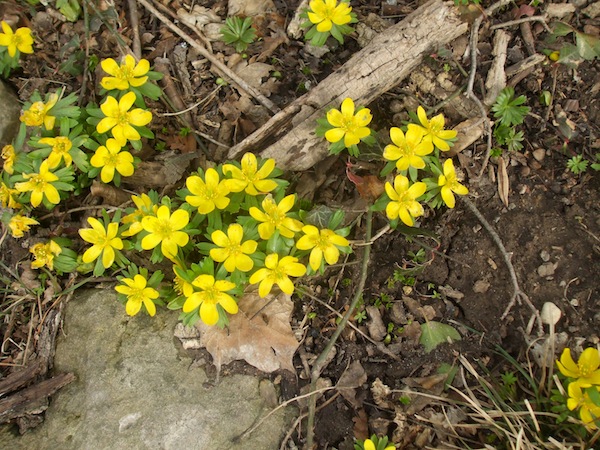
Crocus forms sea of blue in neighbor's yard. (C) Jo Ellen Meyers Sharp
A walk through the neighborhood reveals that spring has finally emerged from its winter sleep.
Landscapes are filled with the earliest blooming bulbs: species crocus, snow drops, winter aconites and the tiny iris reticulata. The Dutch call these special bulbs, but we usually call them minor bulbs.
Last fall, I planted more than 100 Tommie crocus (Crocus tommasinianus), a species type that is great for naturalizing. It will be quite a few years before my front yard looks like a neighbors, which literally looks like a sea of lavendar blue. Each year, the sea gets larger and larger as these crocus send their seeds flying. Chipmunks and squirrels tend to ignore these tiny bulbs.

Winter aconites. (C) Jo Ellen Meyers Sharp
Not far from the blue is another neighbor whose landscape is filled with winter aconites (Eranthus). These small, daisy-like yellow flowers naturalize, too. They tend to drop seed to form patches of sunny yellow to brighten the landscape. I’ve planted winter aconite a few times, but they have not shown up in great numbers. I’ve had the same touch-and-go relationship with spring anemone (Anemone coronaria) or wood anemone (A. nemerosa).
Also on the spring docket are Iris reticulata, beautiful blooming plants that look like a miniature iris. These come is lots of shades of blue and purple and also yellow and white. These bulbs are extremely hardy and tough. They have naturalized along the hell strip next to the asphalt driveway, where there is a lot of heat bounce and an occasional bit of foot traffic. These tend to spread in clumps as the under ground bulbs multiply.
After years of trying, I’ve finally succeeded in getting a small patch of the snow drops (Galanthus nivalus) to take. They get their name because they frequently bloom in snow, especially if they get good light early in late winter. Here’s hoping their numbers multiply.